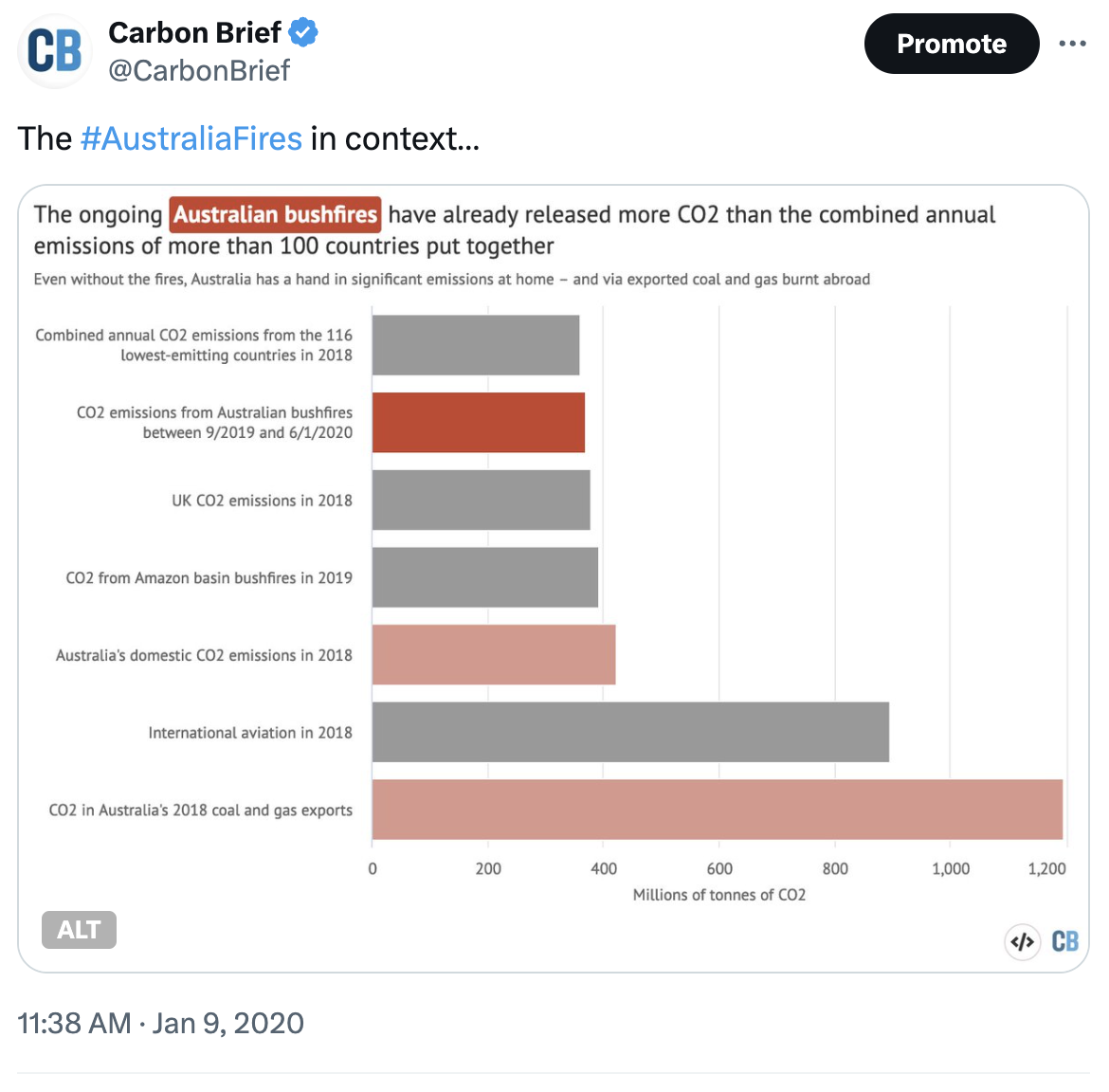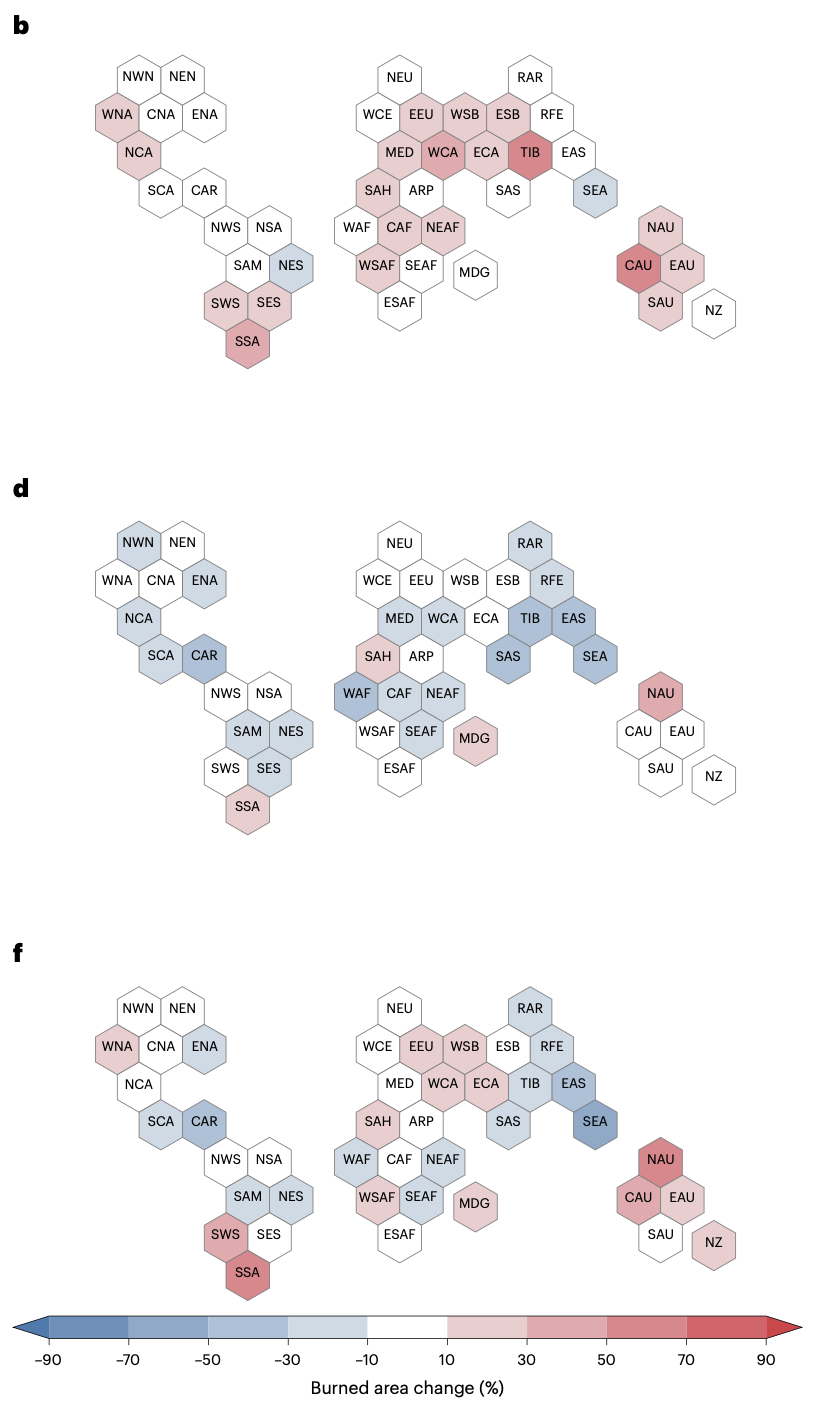A new study finds that the decline in the area covered by global fires in the 20th century due to land-use change was almost entirely offset by increases due to global warming.
The paper, published in the journal Nature Climate Change, is the first attribution study to assess the impact of climate change and land use change on “global burned area.”
It found that changes in population distribution and land use that occurred during the 20th century – including forest fragmentation and land conversion to urban development and agriculture – suppressed the fires, reducing the global area burned by 19%.
However, this decline has been halted by human-induced warming, which has increased the area burned by 16% due to increasingly hot and dry conditions across much of the world.
As a result, the global area burned has decreased by just 5% over the last 100 years.
Despite the overall decline worldwide, the study found that climate change has increased the area burned by 29% in southeastern South America, 22% in northern Australia, 18% in western Siberia and 15% in western North America.
This study is “a key missing piece in the puzzle of tracking anthropogenic emissions,” says Dr. Matthew Jones, an independent researcher who was not involved in the study.
Jones, who is working on the annual Global Carbon Budget (GCP), tells Carbon Brief that this study represents “an important step forward in modeling the extent of additional human-caused wildfires.” He notes that until now, projects like GCB “have been forced to assume that all fire emissions are natural, and therefore have underestimated the human impact on the global carbon cycle.”
The burned area paradox
Australia’s 2020-2021 ‘black summer’ bushfires are one of the most intense and destructive fire seasons on record on the continent. The fires burned almost 25 million hectares of land, killed more than 30 people and emitted more CO2 than the combined annual emissions of over 100 countries.

Scientists from the World Weather Attribution (WWA) website have published a study on the “rapid attribution” of wildfires in Australia. They found that the likelihood of Australia experiencing weather conditions similar to those preceding the 2020-2021 bushfires has increased by at least 30% since 1900 as a result of climate change.
Similarly, PAH found that climate change has more than doubled the likelihood of extreme fire-related weather conditions that led to the unprecedented wildfires in eastern Canada in 2023. And the hot, dry and windy conditions that caused the devastating Pantanal wildfires in 2024, were 40% more intense due to climate change.
Attribution research clearly shows that climate change is making individual forest fires more intense and more frequent. However, data shows that overall, the area covered by fires around the world is decreasing.
Dr Matthew Jones is an independent researcher working with the Natural Environment Research Council and the Global Carbon Project. He is the lead author of a study published last week that found that between 2001 and 2023, greenhouse gas emissions from forest fires increased by 60% globally.
He tells Carbon Brief that climate change does not provide a complete picture of the global area burned, noting that human activity can impact fires in many ways:
“Fires are a natural phenomenon, but their likelihood is increasing as a result of human-induced climate change. They are also influenced by people who manage much of the Earth’s surface and who change the rate at which fires ignite.
“Fire scientists have long grappled with the difficult task of separating additional human-caused fires in addition to those that would occur naturally.”
Assigning burned area
Seppe Lampe is a PhD student at the Department of Water and Climate at Vrije University in Brussels and co-author of the study. He tells Carbon Brief that “this is the first study to actually describe and quantify the impact of climate change on burned areas around the world.”
The authors use seven “fire-vegetation models” from the Intercomparison Inter-Sector Impact Model project to conduct an attribution study that compares fires in today’s climate with fires in an alternative world without human-caused climate change.
To assess the impact of climate change on global area burned, the authors ran modern climate models (2003-19), both with and without the effects of climate change. They then compare the results to isolate the impact of climate change on the global area burned.
To examine the impact of “direct human forcing” – defined as land use change, land management and population density – they compare simulations of the world at the beginning of the industrial era (1901–17) and the modern world (2003–2019). ) without the impact of climate change. The authors do not account for any long-term climate change in these simulations, so the only differences are land use and population changes.
The maps below show the percentage change in area burned due to climate change (top), direct human forcing (middle), and both (bottom). Red means an increase in the percentage of burned area, blue means a decrease. White indicates that there has been a slight change in the percentage of area burned. The map divides the world into hexagonal regions as determined by the Intergovernmental Panel on Climate Change (IPCC).
 Percentage change in area burned due to climate change (top), direct human forcing (middle), or both (bottom). Red means an increase in the percentage of burned area, blue means a decrease. The hexagons indicate regions of the world, as in the IPCC. Source: Burton et al. (2024).
Percentage change in area burned due to climate change (top), direct human forcing (middle), or both (bottom). Red means an increase in the percentage of burned area, blue means a decrease. The hexagons indicate regions of the world, as in the IPCC. Source: Burton et al. (2024).
Climate and land use change
The study found that climate change has caused an increase in burned area in most IPCC regions, with only eight of 42 regions seeing a decline in burned area due to the changing climate.
Lampe explains that the climate-driven decline in area burned in regions such as Southeast Asia may be due to factors such as changing rainfall patterns.
Many regions have seen more than 10% increases in area burned due to climate change alone, the study adds, including all IPCC regions in Australia and several regions in South America, Siberia and North America.
The authors find that climate change has caused an average 16% increase in area burned globally and increased the likelihood of months with above-average global area burned by 22%.
The authors add that it is currently estimated that the area of land that would be burned by the two most active wildfires a year in a world without climate change will burn for four months of the year.
The authors also found that the impact of climate change on the area burned is accelerating over time, with the most rapid increase after the 1970s. The biggest increases were in Central Australia.
On the other hand, the authors find that changes in direct human factors since the early industrial period have resulted in a 19.1% reduction in the area burned.
According to the study, this is due to landscape fragmentation, reductions in fire fuel consumption – often seen as landscapes transform from natural areas to urban areas or farmland – and targeted fire management and suppression techniques.
The decline in area burned is mainly seen in savannahs, grasslands and croplands – particularly in equatorial Asia and tropical North Africa – Lampe tells Carbon Brief. Adds:
“The global signal of burned area is actually 70% determined by what happens in African savannahs. We are seeing more and more savannahs being converted to farmland, which is reducing the area burned.”
Overall, the study showed a 5% reduction in global area burned since the beginning of the 20th century.
“An important step forward”
The study shows that without the “mitigating influences” of land use change, the global area burned would likely be even greater today.
The work represents “an important step forward in modeling the extent of additional human-caused wildfires,” Jones tells Carbon Brief. Adds:
“Until now, projects like the Global Carbon Budget have found it difficult to estimate how humans are affecting the climate through wildfire emissions. We have been forced to assume that all fire emissions are natural, so we underestimate the human impact on the global carbon cycle.”
He explains that this study is “a key missing piece in the puzzle of tracking anthropogenic emissions.”
Professor David Bowman is an Australian Research Council Scholar and Director of the Transdisciplinary Center for Firefighting at the University of Tasmania. He tells Carbon Brief that the approach used in this study seems “important”, but adds that modeling forest fires is “extremely difficult”.
The “useful” study points out several important assumptions and caveats – for example, the fact that the authors do not take into account the intensity of fires.
Bowman also warns that the reduction in global area burned “has been used for political purposes, diverting attention from the escalating wildfire crisis.”
Dr. Maria Barbosa – a researcher at the Universidade Federal de São Carlos who was not involved in the study – tells Carbon Brief that the study “provides valuable information on the likely change in fire regimes.”
Barbosa warns that “we are currently not preparing for upcoming fire seasons” and says governments must invest in early warning systems, improve land-use planning to reduce wildfire risk, and strengthen forest management and restoration policies.
Lampe tells Carbon Brief that the findings from this study could help inform regional decision-makers and “may have implications for loss and damage.”
Sharelines from this story